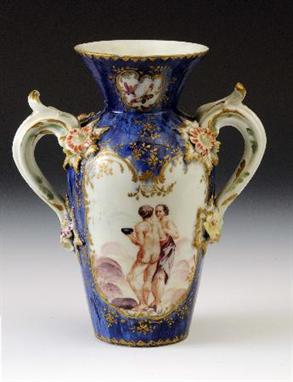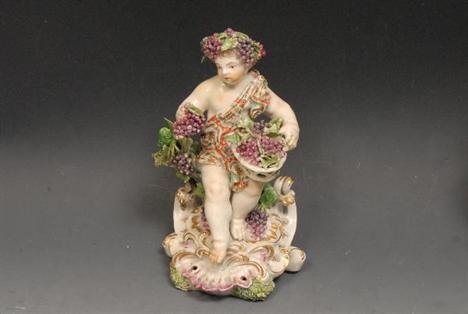We found 24353 price guide item(s) matching your search
There are 24353 lots that match your search criteria. Subscribe now to get instant access to the full price guide service.
Click here to subscribe- List
- Grid
-
24353 item(s)/page
A Derby Patch Mark two-handled tapering ovoid vase, possibly from a garniture, with funnel shaped neck, painted with birds perched on branches, the verso with two figures, one naked the other scantily draped within gilt foliate scroll cartouches on a mottled blue ground, the scroll handles with flowers applied to the terminals, lightly picked out in gilt, gilt chevron borders, 20cm high, c.1760 Reference: Twitchett, John. DERBY PORCELAIN 1748-1848. Woodbridge, Suffolk : Antique Collectors` Club, 2002. pp.253, color pl. 251. Other vases of similar form and decoration are illustrated by John Twitchett, Derby Porcelain, pl 27, p 48 and Dennis G Rice, Derby Porcelain, The Golden Years, pl 132, p 157. This style of decoration has often been attributed in the past to an outside London decorator, presumably because of the similarities to Chelsea examples of the gold anchor period. However, the colours used and the bird and moth painting are distinctly Derby in style
A set of four Derby Patch Mark figures, Allegorical of the Four Seasons, Spring, he stands, wearing a broad brimmed black hat, holding a flower posy, Summer, she stands bare footed with a bundle of wheat, Autumn, she stands holding a basket of grapes, Winter, he stands wearing a fur lined coat, with a bundle of kindling on his shoulder, each on circular base, 18cm high, incised no.123, c.1770
Group of 6 Medals: 1939/45 Star, Africa Star with First Army Bar, Italy Star, Defence Medal 1939-45, 1939-45 War Medal, Territorial Army Medal for Officiant Service all on ribbons & Associated Items inc. scanned copies relating to QMS Byles GR, Army Book 64 Solider`s Service & Paybook, scanned photographs of Byles as a child dressed in naval uniform & on his wedding day & original photograph of him in military dress, buttons, pins, Sgt`s Mess Member Card Book, Royal Army Medical Corps Sew-on Patch, box presented to Byles as a wedding present by Mahmoud Abdol Monneen, cross country run medallion dated 1933, Royal Army Medical Corps Pins, enamelled 1940-1-2-3 HG, ARP, etc.
Victoria, young head, AR: crowns, 1844 and 1845, halfcrowns, 1845, worn, 1874, 1875, 1879, 1883, 1885 and 1887 (3), two of latter fine, shillings, 1839, 1846, 1856, 1864, 1870, 1873, 1880, 1881, 1883, 1884, 1885 and 1887, sixpences, 1838, scratched and marked, 1857, 1858, 1881 and 1884, groats, 1848 and 1855 and threehalfpence, 1841, fair, unless stated, latter with corrosion patch above head, otherwise extremely fine (31)
Victoria, young head, AR: crown, 1845, halfcrown, 1886, shillings, 1842, 1877 and 1883, latter very fine, sixpence, 1871 and groat, 1849, copper: pennies, 1847, 1854, 1855 and 1857, latter good very fine, halfpennies, 1855 and 1858, first has discolouration patch to obv., otherwise very fine or better and farthing, 1854 and bronze: pennies, 1860, toothed border, 1862, 1863, 1866, 1876 H and 1890 and halfpenny, 1885, bronze mainly fine, otherwise fair or better, unless stated (21)
Two bevelled glass photograph frames with gilt cresting, on bun feet, with easel stands, 13cm x 7cm; an enamel hinged patch box, the cover painted with a river landscape, 6cm wide; a small tortoiseshell purse, inlaid with silver piquet and mother of pearl; an early 20thC notebook with EPNS cover and chatelaine ring; a small circular box and cover, inset with a small seascape, and three other items. (9)
A late 18th century Bilston enamel oval patch box, the hinged cover painted with a scene depicting a woman and a dog beneath a tree in open countryside and with a badly pitted mirrored lining, the base in duck egg blue with white interior. App. 4 cms wide (as viewed, some hair lined cracks and chips to the base)
A collection of three dressing table pieces, to include; a glass and silver mounted jar with tortoiseshell mounted cover, Birmingham 1924, 8.5cm diameter, a small silver circular patch box with tortoiseshell inset top London 1918, 4.8cm diameter and a bedside timepiece with tortoiseshell frame, 8.5cm high (3)
Salyut 7 Helium Tank Salyut 7 space station artefact Salyut 7 Spacecraft - Helium Tank - fell 7th February 1991 This is a helium tank from the Russian Salyut 7-Cosmos 1686 (Kosmos 1686) spacecraft assembly, which went out of control and fell to Earth as a fireball, 3 to 4 years earlier than expected. Russian mission control put the spacecraft into a spin and tried to control the impact into the Atlantic Ocean as 70kg of fuel still remained onboard. This attempt failed and after a bright fireball that was witnessed by many local people, some fragments fell near the town of Capitan Bermudez, 250 miles from Buenos Aires, Argentina at 01:00 local time on 7th February 1991. The 14 inch diameter, 7.4kg, mostly titanium sphere is peppered with several hundred perfectly formed craters caused by tiny micrometeoroids which impacted on the surface during it`s many years in space. Opposing ends have a mounting rod and a coupling/inlet valve respectively - each has ablated heavily during re-entry and streamers of molten material have been blown back onto the leading faces of the sphere, clearly showing the orientation of flight. Dark scorching on one side of the main body is evidence that the sphere `flipped` during flight as external mountings and couplings broke/ablated away, and for a brief few moments this side was the leading edge before orienting itself once more. This dark patch of side scorching also shows a much lighter coloured `shadow` band where another part of the spacecraft, or possibly the departing mounting rod, momentarily protected this part of the sphere from scorching, and left an outline image of itself in the process. Due to its almost perfectly spherical shape and the high melting point of its titanium chemistry, the main body of the sphere escaped complete ablation of its surface, thus preserving the many micrometeoroid craters. However, the irregularly shaped mounting rod and the opposing coupling/inlet valve have a thick layer of dark fusion crust with fine flow lines that are similar to the surface of a freshly recovered iron meteorite. Some of the crater `pits` were undoubtedly caused by other parts of the spacecraft that were ablating in front of the spherical tank during atmospheric passage and also by other man-made orbiting debris from earlier space missions that impacted during its 9 plus years in space. This tank has been the subject of much research into the composition of the craters at the Natural History Museum, London. A paper entitled: "Analysis of Impact Residues on Spacecraft Surfaces: Possibilities and Problems" has been written about this Salyut helium tank and was presented at the 3rd European Conference on Space Debris, with a proceedings paper.
A silver mounted and glass scent bottle, London 1902, with trailing leaf decoration, William Comyns, together with a silver and blue enamel handle ivory letter opener, Birmingham 1909, marked C & N, a Eastern European silver salt, with incised decoration, marks rubbed, a pair of silver plated salts and spoons in the form of fish and a papier mache patch box, (a Lot).
-
24353 item(s)/page
























